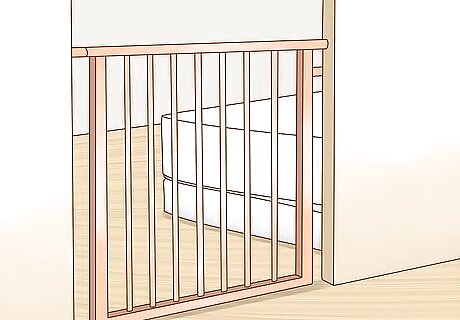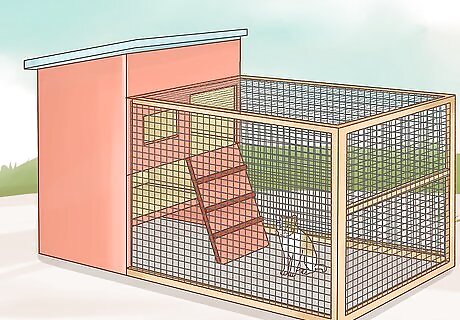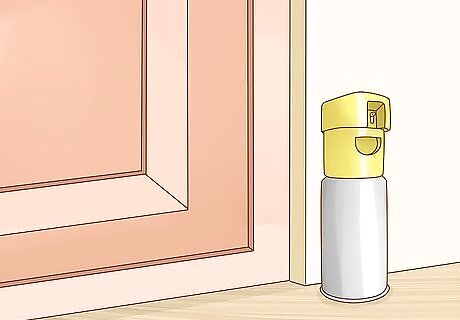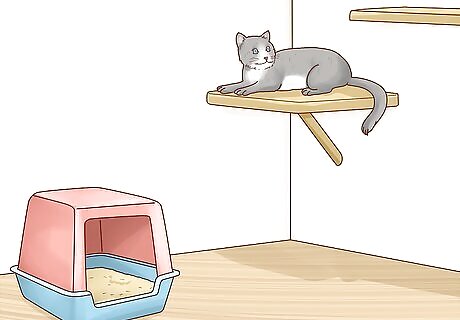
views
Blocking Your Cat From Entering a Room

Shut the door to the room you want to keep your cat out of. This is the most effective way of keeping a cat out of a space you don't want it in. If the room doesn't have a door, put one on as soon as you can. Be aware that this provides a physical barrier to the cat's entry, yet the cat may still try to get in because it's curious about whats on the other side of the door. By denying the cat access to a room that it wants to go into, you may increase the cat's stress. This can inadvertently shift bad behaviour to another part of the house. Ideally, only deny access as an emergency measure whilst seeking the advice of a qualified animal behaviourist or your veterinarian.

Make a habit of coming in and exiting doors quickly. It can be hard to keep a cat out of a room it wants to get into, so you are going to have to act fast! It's a good idea to try to distract the cat with toys and treats so you can enter the room with enough time to shut the door behind you.

Create an alternative barrier if the room has no door. It may be hard to create a physical barrier that will keep all cats out, but try to make a barrier designed to your specific cat's agility. For instance,e while baby gates will not work for all cats, if your cat is only slightly interested in the room or your cat is old or not agile, a small baby gate may deter your cat from entering the room.

Keep your cat in an outdoor cattery. Only allow the cat to roam inside on your terms, at your convenience, when you can shut as many doors as you'd like. This way, you don't have to worry about the cat's whereabouts when locked away snugly in its own house. However, this is severely limiting the cat's territory which can lead to stress. Stress can manifest itself as destructive behaviour, inappropriate urination or defecation, or indeed some cats will become ill with bladder problems. To minimize this risk make sure your cat has plenty of room to roam. Provide high perches for the cat to sit on and look around, hiding places so the cat can have privacy when necessary, and litter box, food and water bowls. If the run is outdoors, also make sure there is adequate protection from wind, rain, and direct sun. Make sure the cat has mental stimulation, so this includes providing toys, spending a minimum of two, ten minutes play sessions a day with the cat, and giving the cat plenty of attention.

Ignore the cat if it is scratching at the door and you are in the room. If you scold a cat, he or she will do it again. If the "game" your cat is playing has no merit, it won't bother again.

Place a deterrent at the door. If it is essential the cat does not scratch at the door, try siting a canister of compressed air with a motion detector trigger, beside the door. When the motion detector picks up the cat it releases a blast of compressed air which does not harm the cat, but gives him a fright. The cat then learns to associate that door with an unpleasant experience and will be more wary about approaching.
Making a Room Undesirable to a Cat

Make the room physically uncomfortable for the cat. Sometimes you can't put a physical barrier up to keep your cat out of a room. In this case, you will need to make the room uncomfortable for it to be in. Make loud noises whenever it enters the room or shoo it away. Note that if you do this, the cat may associate the noise with you and start to avoid you. You can even employ stronger methods in some cases. For example, spill a small amount of water on the floor of your bathroom if you don't want your cat in there. A cat may hate to get its feet wet on any excess water on the floor. Another example is to make sure the cat has nowhere to hide in a room. Sometimes a cat likes going under beds or in corners to feel safe. With this type of cat you can block off access to under the bed or any other hiding spaces. This will make your cat uncomfortable in the room.

Spray the cat with water from a spray bottle. Every time it goes near the room, have a spray bottle ready to spray a little water at it. This will make sure it knows that its actions are unacceptable. However, only use this method if you are prepared to accept damaging your relationship with the cat. It is highly likely the cat will associate the water spray with you, the sprayer, rather than the room. Thus, the cat is more likely to flee and not want to spend time in your company.

In addition, there are commercial electronic cat deterrents that will spray a cat with a burst of air when it approaches the room. You simply place the device in the doorway to the room and let it deter your cat from the area.

Place smells in the room that your cat doesn't like. Put a small amount of vinegar at the room's entrance or in areas of the room. This usually helps, as most cats hate the odor of vinegar. This advice is anecdotal, however, as some people find it helps while for others it makes no difference. Alternatively, fill a spray bottle halfway with vinegar. Fill the other half with lime or lemon juice. Spray at the entrance to the room and on beds and other places the cat usually goes. This will deter many cats from scratching on furniture or spending time in the room. If you go this route, the vinegar spray needs fairly constant reapplication.

Redirect your cat's attention. Make a different room more comfortable for the cat. Make another room cat-appealing so the cat will go there instead. Offer the cat several nice sleeping places (although it's likely to chose its own) including a high perch. Provide food, water, and a litter tray, as well as toys.

Use positive training. This involves making a big fuss of the cat and making being in the room you want it to be in a pleasant experience. The goal is to make sure your cat associates the room with good things and wishes to return there. You may want to scatter extra tasty treats around the room so that it seems a more appealing place.



















Comments
0 comment